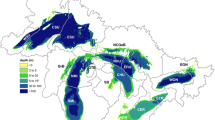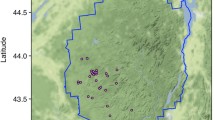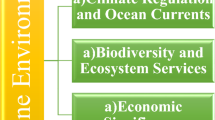Abstract
Long-term ecological research has become a cornerstone of the scientific endeavour to better understand ecosystem responses to environmental change. This paper provides a perspective on how such research could be advanced. It emphasizes that a profound understanding of the mechanisms underlying these responses requires that records of ecologic processes be not only sufficiently long, but also collected at an appropriate temporal resolution. We base our argument on an overview of studies of climate impacts in limnic and marine ecosystems, suggesting that lakes and oceans respond to (short-term) weather conditions during critical time windows in the year. The observed response patterns are often time-lagged or driven by the crossing of thresholds in weather-related variables (such as water temperature and thermal stratification intensity). It becomes clear from the previous studies that average annual, seasonal or monthly climate data often fall short of characterizing the thermal dynamics that most organisms respond to. To illustrate such literature-based evidence using a concrete example, we compare 2 years of water temperature data from Müggelsee (Berlin, Germany) at multiple temporal scales (from hours to years). This comparison underlines the pitfalls of analysing data at resolutions not high enough to detect critical differences in environmental forcing. Current science initiatives that aim at improving the temporal resolution of long-term observatory data in aquatic systems will help to identify adequate timescales of analysis necessary for the understanding of ecosystem responses to climate change.



Similar content being viewed by others
References
Aberle N, Lengfellner K, Sommer U (2007) Spring bloom succession, grazing impact and herbivore selectivity of ciliate communities in response to winter warming. Oecologia 150:668–681
Adrian R (1997) Calanoid-cyclopoid interactions: evidence from an 11-year field study in a eutrophic lake. Freshw Biol 38:315–325
Adrian R, Deneke R, Mischke U, Stellmacher R, Lederer P (1995) A long-term study of the Heiligensee (1975–1992). Evidence for effects of climatic change on the dynamics of eutrophied lake ecosystems. Arch Hydrobiol 133(3):315–337
Adrian R, Wilhelm S, Gerten D (2006) Life history traits of lake plankton species may govern their phenological response to climate warming. Global Change Biol 12:652–661
Alheit J, Möllmann C, Dutz J, Kornilovs G, Loewe P, Mohrholz V, Wasmund N (2005) Synchronous ecological regime shifts in the central Baltic and the North Sea in the late 1980s. ICES J Mar Sci 62:1205–1215
Anderson NJ (1995) Temporal scale, phytoplankton ecology and palaeolimnology. Freshw Biol 34(2):367–378
Batten SD, Mackas DL (2009) Shortened duration of the annual Neocalanus plumchrus biomass peak in the Northeast Pacific. Mar Ecol Prog Ser 393:189–198
Beaugrand G, Reid PC, Ibanez F, Lindley JA, Edwards M (2002) Reorganization of North Atlantic marine copepod biodiversity and climate. Global Change Biol 296:1692–1694
Beaugrand G, Edwards M, Brander K, Luczak C, Ibanez F (2008) Causes and projections of abrupt climate-driven ecosystem shifts in the North Atlantic. Ecol Lett 11:1157–1168
Benndorf J, Kranich J, Mehner T, Wagner AK (2001) Temperature impact on the midsummer decline of Daphnia galeata: an analysis of long-term data from the biomanipulated Bautzen Reservoir (Germany). Freshw Biol 46:199–211
Blenckner T, Adrian R, Livingstone DM, Jennings E, Weyhenmeyer GA, George DG, Jankowski T, Jarvinen M, Aonghusa CN, Nõges T, Straile D, Teubner K (2007) Large-scale climatic signatures in lakes across Europe: a meta-analysis. Global Change Biol 13:1314–1326
Brander KM (2005) Cod recruitment is strongly affected by climate when stock biomass is low. ICES J Mar Sci 62:339–343
Carpenter SR, Cole JJ, Pace ML, Batt R, Brock WA, Cline T, Coloso J, Hodgson JR, Kitchell JK, Seekell DA, Smith L, Weidel B (2011) Early warnings of regime shifts: a whole-ecosystem experiment. Science 332:1079–1082
Chan KS (2010) TSA: time series analysis. R package version 0.98. http://CRAN.R-project.org/package=TSA
Cottingham KL, Brown BL, Lennon JT (2001) Biodiversity may regulate the temporal variability of ecological systems. Ecol Lett 4:72–85
Dakos V, Scheffer M, van Nes EH, Brovkin V, Petoukhov V, Held H (2008) Slowing down as an early warning signal for abrupt climate change. Proc Natl Acad Sci 150(38):14308–14312
De Senerpont Domis LN, Mooij WM, Hülsmann S, van Nes EH, Scheffer M (2007) Can overwintering versus diapausing strategy in Daphnia determine match-mismatch events in zooplankton-algae interactions? Oecologia 150:682–698
deYoung B, Harris R, Alheit J, Beaugrand G, Mantua N, Shannon L (2004) Detecting regime shifts in the ocean: data considerations. Prog Oceanogr 60:143–164
Dippner JW, Ottersen G (2001) Cod and climate variability in the Barents Sea. Clim Res 17:73–82
Drake JM, Griffen BD (2010) Early warning signals of extinction in deteriorating environments. Nature 467:456–459
Drinkwater KF, Belgrano A, Borja A, Conversi A, Edwards M, Greene CH, Ottersen G, Pershing AJ, Walker H (2003) The response of marine ecosystems to climate variability associated with the North Atlantic Oscillation. In: Hurrell J Kushnir Y, Ottersen G, Visbeck M (eds) The North Atlantic Oscillation. Climate significance and environmental impact. Geophysical Monograph 143, pp 211–234
Edwards M, Richardson AJ (2004) Impact of climate change on marine pelagic phenology and trophic mismatch. Nature 430:881–884
Elliott JA (2010) The seasonal sensitivity of cyanobacteria and other phytoplankton to changes in flushing rate and water temperature. Global Change Biol 16:864–876
Elliott JA, Jones ID, Thackeray SJ (2006) Testing the sensitivity of phytoplankton communities to changes in water temperature and nutrient load, in a temperate lake. Hydrobiologia 559:401–411
Engle RF (1982) Autoregressive conditional heteroscedasticity with estimates of variance of United Kingdom inflation. Econometrica 50(4):987–1007
Gaedke U, Ruhenstroth-Bauer M, Wiegand I, Tirok K, Aberlew N, Breithaupt P, Lengfellner K, Wohlers J, Sommer U (2010) Biotic interactions may overrule direct climate effects on spring phytoplankton dynamics. Global Change Biol 16:1122–1136
George DG, Hewitt DP (2006) The impact of year-to-year changes in the weather on the dynamics of Daphnia in a thermally stratified lake. Aquat Ecol 40:33–47
Gerten D (2008) Climatic change, aquatic science, multiple shifts in paradigms. Int Rev Hydrobiol 93:397–403
Gerten D, Adrian R (2000) Climate-driven changes in spring plankton dynamics and the sensitivity of shallow polymictic lakes to the North Atlantic Oscillation. Limnol Oceanogr 45(5):1058–1066
Gerten D, Adrian R (2001) Differences in the persistency of the North Atlantic Oscillation signal among lakes. Limnol Oceanogr 46(2):448–455
Gerten D, Adrian R (2002a) Effects of climate warming, North Atlantic Oscillation and El Niño on thermal conditions and plankton dynamics in European and North American lakes. Sci World J 2:586–606
Gerten D, Adrian R (2002b) Species-specific changes in the phenology and peak abundance of freshwater copepods in response to warm summers. Freshw Biol 47:2163–2173
Hanson PC (2007) A grassroots approach to sensor and science networks. Front Ecol Environ 5(7):343
Hare SR, Mantua NJ (2000) Empirical evidence for North Pacific regime shifts in 1977 and 1989. Prog Oceanogr 47:103–145
Hari RE, Livingstone DM, Siber R, Burkhardt-Holm P, Güttinger H (2006) Consequences of climate change for water temperature and brown trout populations in Alpine rivers and streams. Global Change Biol 12:10–26
Harris GP (2011) Temporal and spatial scales in phytoplankton ecology. Mechanisms, methods, models, and management. Can J Fish Aquat Sci 37(5):877–900
Haury LR, McGowan JA, Wiebe PH (1978) Patterns and processes in the time-space scales of plankton distribution. In: Steele JH (ed) Spatial pattern in plankton communities. Plenum Press, New York, pp 277–327
Helaouet P, Beaugrand G (2007) Macroecology of Calanus finmarchicus and C-helgolandicus in the North Atlantic Ocean and adjacent seas. Mar Ecol Prog Ser 345:147–165
Holste L, Peck MA (2006) The effects of temperature and salinity on egg production and hatching success of Baltic Acartia tonsa (Copepoda: Calanoida): a laboratory investigation. Mar Biol 148:1061–1070
Huber V, Adrian R, Gerten D (2008) Phytoplankton response to climate warming modified by trophic state. Limnol Oceanogr 53(1):1–13
Huber V, Adrian R, Gerten D (2010) A matter of timing: heat wave impact on crustacean zooplankton. Freshw Biol 55:1769–1779
Huber V, Wagner C, Gerten D, Adrian R (2012) To bloom or not to bloom: contrasting responses of cyanobacteria to recent heat waves explained by critical thresholds of abiotic drivers. Oecologia 169:245–256
Huisman J, Sharples J, Stroom JM, Visser PM, Kardinaal WEA, Verspagen JMH, Sommeijer B (2004) Changes in turbulent mixing shift competition for light between phytoplankton species. Ecology 85:2960–2970
Jansen W, Hesslein RH (2004) Potential effects of climate warming on fish habitats in temperate zone lakes with special reference to Lake 239 of the experimental lakes area (ELA), north-western Ontario. Environ Biol Fish 70:1–22
Jöhnk KD, Huisman J, Sharples J, Sommeijer B, Visser PM, Stroom JM (2008) Summer heatwaves promote blooms of harmful cyanobacteria. Global Change Biol 14:495–512
Kirby RR, Beaugrand G, Lindley JA, Richardson AJ, Edwards M, Reid PC (2007) Climate effects and benthic pelagic coupling in the North Sea. Mar Ecol Prog Ser 330:31–38
Langman OC, Hanson PC, Carpenter SR, Chiu K, Hu YH (2010) Control of dissolved oxygen in northern temperate lakes over scales ranging from minutes to days. Aquat Biol 9:193–202
Livingstone DM (2003) Impact of secular climate change on the thermal structure of a large temperate central European lake. Clim Change 57:205–225
Livingstone DM (2008) A change of climate provokes a change of paradigm: taking leave of two tacit assumptions about physical lake forcing. Int Rev Hydrobiol 93:404–414
Magnuson JJ (1990) Long-term ecological research and the invisible present. Bioscience 40(7):495–501
Martens P, van Beusekom JEE (2008) Zooplankton response to a warmer northern Wadden Sea. Helgol Mar Res 62:67–75
Möllmann C, Conversi A, Edwards M (2011) Comparative analysis of European wide marine ecosystem shifts: a large-scale approach for developing the basis for ecosystem-based management. Biol Lett 7:484–486
Mooij WM, Hülsman S, De Senerpont Domis LN, Nolet BA, Bodelier PLE, Boers PCM, Dionisio Pires LM, Gons HJ, Ibelings BW, Noordhuis R, Portielje R, Wolfstein K, Lammens EHRR (2005) The impact of climate change on lakes in the Netherlands: a review. Aquat Ecol 39:381–400
Moss B (2010) Climate change, nutrient pollution and the bargain of Dr. Faustus. Freshw Biol 55:175–187
Mysterud A, Stenseth NC, Yoccoz NG, Ottersen G, Langvatn R (2003) The response of terrestrial ecosystems to climate variability associated with the North Atlantic Oscillation. In: Hurrell J Kushnir Y, Ottersen G, Visbeck M (eds) The North Atlantic Oscillation. Climate significance and environmental impact. Geophysical Monograph 143, pp 235–262
Orlowsky B, Gerstengarbe FW, Werner PC (2008) A resampling scheme for regional climate simulations and its performance compared to a dynamical RCM. Theor Appl Climatol 92(3–4):209–223
Parmesan C (2006) Ecological and evolutionary responses to recent climate change. Annu Rev Ecol Evol Syst 37:637–669
Peeters F, Straile D, Lorke A, Livingstone DM (2007) Earlier onset of the spring phytoplankton bloom in lakes of the temperate zone in a warmer climate. Global Change Biol 13:1898–1909
Pierson DC, Weyhenmeyer GA, Arvola L, Benson B, Blenckner T, Kratz T, Livingstone DM, Markensten H, Marzec G, Pettersson K, Weathers K (2011) An automated method to monitor lake ice phenology. Limnol Oceanogr Methods 9:74–83
Pörtner HO, Farrell AP (2008) Physiology and climate change. Science 322:690–692
Pörtner HO, Knust R (2007) Climate change affects marine fishes through the oxygen limitation of thermal tolerance. Science 315:95–97
Pörtner HO, Peck MA (2010) Climate change effects on fishes and fisheries: towards a cause-and-effect understanding. J Fish Biol 77:1745–1779
Reid PC, Edwards M, Hunt HG, Warner AJ (1998) Phytoplankton change in the North Atlantic. Nature 391:546
Rolinski S, Horn H, Petzoldt T, Paul L (2007) Identifying cardinal dates in phytoplankton time series to enable the analysis of long-term trends. Oecologia 153:997–1008
Rusak JA, Yan ND, Somers KM (2008) Regional climatic drivers of synchronous zooplankton dynamics in north-temperate lakes. Can J Fish Aquat Sci 65:878–889
Sadro S, Melack JM, MacIntyre S (2011a) Depth-integrated estimates of ecosystem metabolism in a high-elevation lake (Emerald Lake, Sierra Nevada, California). Limnol Oceanogr 56(5):1764–1780
Sadro S, Melack JM, MacIntyre S (2011b) Spatial and temporal variability in the ecosystem metabolism of a high-elevation lake: integrating benthic and pelagic habitats. Ecosystems. doi:10.1007/s10021-011-9741-5
Scheffer M, Carpenter SR (2003) Catastrophic regime shifts in ecosystems: linking theory to observation. Trends Ecol Evol 18(12):648–656
Seebens H, Straile D, Hoegg R, Stich HB, Einsle U (2007) Population dynamics of a freshwater calanoid copepod: complex responses to changes in trophic status and climate variability. Limnol Oceanogr 52:2364–2372
Seebens H, Einsle U, Straile D (2009) Copepod life cycle adaptations and success in response to phytoplankton spring bloom phenology. Global Change Biol 15:1394–1404
Shatwell T, Köhler J, Nicklisch A (2008) Warming promotes cold-adapted phytoplankton in temperate lakes and opens a loophole for oscillatoriales in spring. Global Change Biol 14:1–7
Sommer U, Lengfellner K (2008) Climate change and the timing, magnitude, and composition of the phytoplankton spring bloom. Global Change Biol 14:1199–1208
Staehr PA, Bade D, Van de Bogert MC, Koch GR, Williamson CE, Hanson PC, Cole JJ, Kratz T (2010) Lake metabolism and the diel oxygen technique: state of the science. Limnol Oceanogr Methods 8:628–644
Straile D (2002) North Atlantic Oscillation synchronizes food web interactions in central European lakes. Proc R Soc Lond B 269:391–395
Straile D, Müller H (2010) Response of Bosmina to climate variability and reduced nutrient loading in a large lake. Limnologica 40:92–94
Straile D, Livingstone DM, Weyhenmeyer GA, George DG (2003) The response of freshwater ecosystems to climate variability associated with the North Atlantic Oscillation. In: Hurrell J Kushnir Y, Ottersen G, Visbeck M (eds) The North Atlantic Oscillation. Climate significance and environmental impact. Geophysical Monograph 143, pp 263–279
Straile D, Eckmann R, Jüngling T, Thomas G, Löffler H (2007) Climate variability influence on whitefish (Coregonus lavaretus) year-class strength in a deep, warm-monomictic lake. Oecologia 151:521–529
R Development Core Team (2010) R: a language and environment for statistical computing. R Foundation for Statistical Computing, Vienna, Austria. ISBN 3-900051-07-0, http://www.R-project.org/
Teubner K, Feyerabend R, Henning M, Nicklisch A, Woitke P, Kohl JG (1999) Alternative blooming of Aphanizomenon flosaquae or Planktothrix agardhii induced by the timing of the critical nitrogen:phosphorus ratio in hypertrophic riverine lakes. Arch Hydrobiol Adv Limnol 54:325–344
Van Nes EH, Scheffer M (2007) Slow recovery from perturbation as a generic indicator of a nearby catastrophic shift. Am Nat 169:738–747
Veraart AJ, Faassen EJ, Dakos V, van Nes EH, Lürling M, Scheffer M (2012) Recovery rates reflect distance to a tipping point in a living system. Nature 481:357–359
Wagner C, Adrian R (2009a) Cyanobacteria dominance: quantifying the effects of climate change. Limnol Oceanogr 54:2460–2468
Wagner C, Adrian R (2009b) Exploring lake ecosystems: hierarchy responses to long-term change? Global Change Biol 5:1104–1115
Wagner C, Adrian R (2011) Consequences of changes in thermal regime for plankton diversity and trait composition in a polymictic lake: a matter of temporal scale. Freshw Biol 56:1949–1961
Wagner A, Benndorf J (2007) Climate-driven warming during spring destabilises a Daphnia population: a mechanistic food web approach. Oecologia 151:351–364
Weijerman M, Lindeboom H, Zuur AF (2005) Regime shifts in marine ecosystems of the North Sea and Wadden Sea. Mar Ecol Prog Ser 298:21–39
Weyhenmeyer GA, Blenckner T, Pettersson K (1999) Changes of the plankton spring outburst related to the North Atlantic Oscillation. Limnol Oceanogr 44:1788–1792
Wickham H (2009) ggplot2: elegant graphics for data analysis. Springer, New York
Wiedner C, Rücker J, Brüggemann R, Nixdorf B (2007) Climate change affects timing and size of populations of an invasive cyanobacterium in temperate regions. Oecologia 152:473–484
Wilhelm S, Adrian R (2007) Long-term response of Dreissena polymorpha larvae to physical and biological forcing in a shallow lake. Oecologia 151:104–114
Wilhelm S, Adrian R (2008) Impact of summer warming on the thermal characteristics of a polymictic lake and consequences for oxygen, nutrients and phytoplankton. Freshw Biol 53:226–237
Wilhelm S, Hintze T, Livingstone DM, Adrian R (2007) Long-term response of daily epilimnetic temperature extrema to climate forcing. Can J Fish Aquat Sci 63:2467–2477
Wiltshire KH, Manly BFJ (2004) The warming trend at Helgoland Roads, North Sea: phytoplankton response. Helgol Mar Res 58:269–273
Winder M, Hunter DA (2008) Temporal organization of phytoplankton communities linked to physical forcing. Oecologia 156:179–192
Winder M, Schindler DE (2004) Climatic effects on the phenology of lake processes. Global Change Biol 10:1844–1856
Winder M, Schindler DE, Essington TE, Litt AH (2009) Disrupted seasonal clockwork in the population dynamics of a freshwater copepod by climate warming. Limnol Oceanogr 54:2493–2505
Wissel C (1984) A universal law of the characteristic return time near thresholds. Oecologia 65:102–107
Acknowledgments
The German Science Foundation funded our research through the Aquashift priority program (DFG AD 91/12-1/2) and the Lake Risk project (AD 91/13-1) and the European Union under the Seventh Framework Programme through BIOFRESH and REFRESH.
Author information
Authors and Affiliations
Corresponding author
Additional information
Communicated by M. Winder.
Rights and permissions
About this article
Cite this article
Adrian, R., Gerten, D., Huber, V. et al. Windows of change: temporal scale of analysis is decisive to detect ecosystem responses to climate change. Mar Biol 159, 2533–2542 (2012). https://doi.org/10.1007/s00227-012-1938-1
Received:
Accepted:
Published:
Issue Date:
DOI: https://doi.org/10.1007/s00227-012-1938-1




